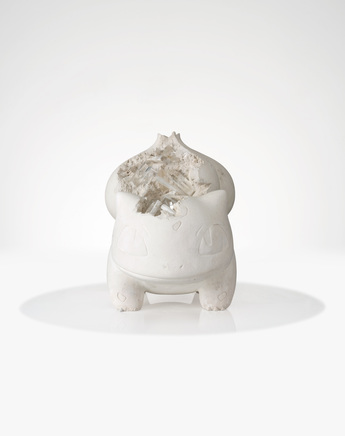-
From Current Issue
-
- Editor’s Letter Fire in the Heart
- Reviews I Gusti Ayu Kadek Murniasih
- Reviews 11th Seoul Mediacity Biennale: “One Escape at a Time”
- Dispatch Networked China
- One on One Monira Al Qadiri on Yukio Mishima
- Essays The rise of independent art spaces in pandemic-era Shanghai
- Features Tuan Andrew Nguyen
- Table of Contents
- Web Exclusives
- Archive
- Subscribe

R
E
V N
E
X
T
Installation view of DANIEL ARSHAM and POKÉMON’s “Relics of Kanto Through Time,” at Nanzuka, Tokyo, 2020. Copyright the artist and Pokémon. Registered trademark Nintendo. Courtesy Nanzuka.
Debuted at Nanzuka Gallery and set to open at Parco Museum Tokyo in August, Daniel Arsham’s exhibition “Relics of Kanto Through Time (ROKTT)” romanticized the gradual breakdown of global capitalism, and envisioned how consumers might shape the archaeological future.
A collaboration between the New York-based artist and the Pokémon Company, the exhibition featured 15 sculptures of iconic characters and objects from the video-game franchise. Arsham was the first artist ever granted access to the Pokémon archives, where he referenced official digital files to create hand-sculpted molds and cast knee-high sculptures of the iconic “pocket monsters”; the boy Trainer; and the Poké Balls and trading cards that make up the brand’s media mix. Instead of their original, bright color combinations, however, the scaled-up replicas were all cast from either smooth, stark-pale resin or oxidized bronze, appearing worn and weathered by time. Missing chunks and corners exposed clusters of otherworldly, glittering crystals. As the sculptures lined the periphery of Nanzuka’s white-cube gallery, the space felt like a time vacuum in which visitors confronted the fated obsolescence of objects that define their commercial present.
The sleek cast sculpture and flashy embedded crystals are immediately recognizable as Arsham’s signature neo-pop aesthetic. Like his hypebeast contemporaries KAWS, MR., and Takashi Murakami, Arsham seamlessly integrates popular and street culture, such as comics, graffiti, sneakers, and skateboards, with “high art,” in the form of painting, drawing, and sculpture. Displayed atop custom plinths, Pikachu (White), Eevee (White), and Bulbasaur (White) (all 2020)—based on soft, sweet, colorful creatures—evoke hard, age-bleached marble that emits the formal gravitas of ancient Greco-Roman statuary.
“ROKTT” is an extension of Arsham’s ongoing speculative series on “future archaeology,” which considers the remnants of global capitalist modernity. For Arsham, hierarchies of monetary and cultural value that color our present are irrelevant, as their remains all form the same archaeological record. He has re-casted all sorts of forms into his sculptural aesthetic, from outdated technology, like Telephone (Future Relic FR-05) (2016) and Sony Walkman (Future Relic 07) (2017), to Western canonical artworks, such as the Venus de Milo and Andy Warhol’s Brillo Box, to the logos and products of Dior and other luxury brands.
As Pokémon act as liaisons between the real and imaginary realms in the games, they add a dimension of colliding worlds to Arsham’s projected future: not only between the worlds of Pokémon and humans, but also of fine art and of pop culture. In an animated Uniqlo advertisement for a line of Pokémon/Arsham T-shirts that was released on YouTube, Pikachu, in his classic yellow form, traverses the forest in Kanto, a region of the digital Pokémon world named after a real region of Japan. In a forest clearing, Pikachu encounters a gargantuan statue of himself, which is identical to the 3D Pikachu (White) that appeared in the exhibition. As one mentally toggled between 2D and 3D; commercial advertising and art; artisanal craftsmanship and mass-manufacture; and past and future, the spatio-temporal-cultural dissonance was nearly overwhelming.
The tangential collaboration with Uniqlo is just one example of how the Arsham/Pokémon project self-reflexively toys with global capitalism: fantasizing about its afterlife, but also encouraging the public to participate in capitalist accumulation. Two months before the exhibition opened at Nanzuka, Arsham released an edition of 500 stark-white resin Pikachu for purchase, which were nearly identical to Pikachu (White) in the exhibition. The Pikachu figurines were the debut collectible items sold via Arsham’s new platform, Archive Editions, which sells his wares exclusively in China. In the collectible Pikachu’s packaging, Arsham included a pair of art-handling gloves, which are often used at auction houses to transfer lots to the auction block. When new collectors donned the gloves, they elicited a fetishized experience of connoisseurship or art patronage, in which the patron felt they had a direct hand in elevating the object’s monetary and cultural value. This interaction exposes the degree to which the Arsham/Pokémon collaboration’s significance is contingent upon market success. These pale, ghostly casts are blank slates upon which to project worth, which may be inflated by their exorbitant prices and blatant marketing.
Kaitlin Hao is an editorial intern at ArtAsiaPacific.
Daniel Arsham’s “Relics of Kanto Through Time (ROKTT)” is on view at Nanzuka Gallery, Tokyo, until August 16, 2020.
To read more of ArtAsiaPacific’s articles, visit our Digital Library.


















